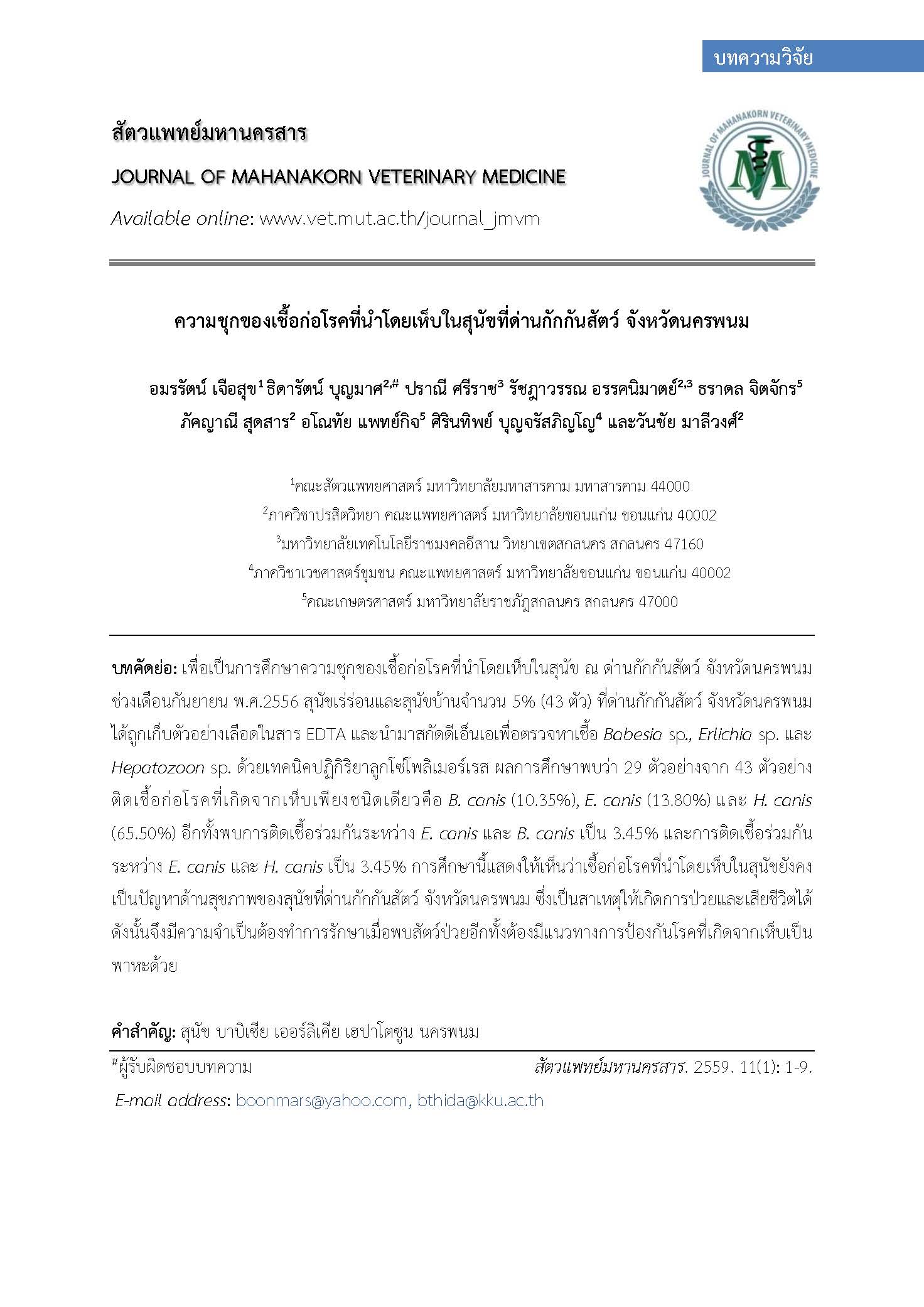Prevalence of Tick-borne Pathogens in Quarantined Dogs at Nakornpranom Animal Quarantine Station, Thailand
Main Article Content
Abstract
To know the prevalence of tick-borne pathogens in quarantined dogs at Nakhonpranom animal quarantine station, Nakornpranom province, Thailand during September, 2013. About 5% (43 dogs) of EDTA-blood from stray and domestic dogs in Nakhonpranom animal quarantine station were collected and extracted DNA for detection of Babesia sp., Erlichia sp. and Hepatozoon sp. using conventional polymerase chain reaction (PCR). The result found that 29 out of 43 were infected with tick borne pathogens. There were single infection with B.canis (10.35%), E.canis (13.80%) and H.canis (65.50%). Co-infection with B.canis, E.canis and H.canis was 3.45%, co-infection with E.canis and B.canis was 3.45% and co-infection with E.canis and H.canis was 3.45%. This study suggests that tick-borne pathogens remain the health problem in dog which may cause of sick and death at Nakhonpranom animal quarantine station, Thailand. Therefore, treatment and prevention of tick-borne disease are extremely needed.
Article Details
References
Aktas, M., Ozubek, S., Altay, K., Ipek, N.D., Balkaya, I., Utuk, A.E., Kirbas, A., Simsek, S. and Dumanli, N. 2015. Molecular detection of tick-borne rickettsial and protozoan pathogens in domestic dogs from Turkey. Parasit. Vectors. 8: 157.
Baneth, G. 2011. Perspectives on canine and feline hepatozoonosis. Vet. Parasitol. 181 (1): 3-11.
Baneth, G. and Weigler, B. 1997. Retrospective case-control study of hepatozoonosis in dogs in Israel. J. Vet. Intern. Med. 11 (6): 365-370.
Bryson, N.R., Horak, I.G., Hohn, E.W. and Louw, J.P. 2000. Ectoparasites of dogs belonging to people in resource-poor communities in North West Province, South Africa. J. S. Afr. Vet. Assoc. 71 (3): 175-179.
Coutinho, M.T., Bueno, L.L., Sterzik, A., Fujiwara, R.T., Botelho, J.R., De Maria, M., Genaro, O. and Linardi, P.M. 2005. Participation of Rhipicephalus sanguineus (Acari: Ixodidae) in the epidemiology of canine visceral leishmaniasis. Vet. Parasitol. 128: 149-155.
Dantas-Torres, F. 2008. Canine vector-borne diseases in Brazil. Parasit. Vectors. 1: 25.
De Tommasi, A.S., Otranto, D., Dantas-Torres, F., Capelli, G., Breitschwerdt, E.B. and de Caprariis, D. 2013. Are vector-borne pathogen co-infections complicating the clinical presentation in dogs? Parasit. Vectors. 6: 97.
Demma, L.J., Traeger, M.S., Nicholson, W.L., Paddock, C.D., Blau, D.M., Eremeeva, M.E., Dasch, G.A., Levin, M.L., Singleton, J., Jr., Zaki, S.R., Cheek, J.E., Swerdlow, D.L. and McQuiston, J.H. 2005. Rocky Mountain spotted fever from an unexpected tick vector in Arizona. N. Engl. J. Med. 353: 587-594.
Gray, J., Dantas-Torres, F., Estrada-Pena, A. and Levin, M. 2013. Systematics and ecology of the brown dog tick, Rhipicephalus sanguineus. Ticks Tick Borne Dis. 4 (3): 171-180.
Harrus, S. and Waner, T. 2011. Diagnosis of canine monocytotropic ehrlichiosis (Ehrlichia canis): an overview. Vet. J. 187 (3): 292-296.
Homer, M.J., Aguilar-Delfin, I., Telford, S.R., Krause, P.J. and Persing, D.H. 2000. Babesiosis. Clin. Microbiol. Rev. 13: 451-469.
Irwin, P.J. 2009. Canine babesiosis: from molecular taxonomy to control. Parasit. Vectors. 2 Suppl 1: 54.
Jittapalapong, S., Rungphisutthipongse, O., Maruyama, S., Schaefer, J.J. and Stich, R.W. 2006. Detection of Hepatozoon canis in stray dogs and cats in Bangkok, Thailand. Ann. N. Y. Acad. Sci. 1081: 479-488.
Krause, P.J., Telford, S., 3rd, Spielman, A., Ryan, R., Magera, J., Rajan, T.V., Christianson, D., Alberghini, T.V., Bow, L. and Persing, D. 1996. Comparison of PCR with blood smear and inoculation of small animals for diagnosis of Babesia microti parasitemia. J. Clin. Microbiol. 34: 2791-2794.
Laummaunwai, P., Sriraj, P., Aukkanimart, R., Boonmars, T., Boonjaraspinyo, S., Sangmaneedet, S., Potchimplee, P., Khianman, P. and Maleewong, W. 2014. Molecular detection and treatment of tick-borne pathogens in domestic dogs in Khon Kaen, northeastern Thailand. Southeast Asian J. Trop. Med. Public Health. 45: 1157-1166.
Matjila, P.T., Leisewitz, A.L., Jongejan, F. and Penzhorn, B.L. 2008. Molecular detection of tick-borne protozoal and ehrlichial infections in domestic dogs in South Africa. Vet. Parasitol. 155: 152-157.
Moraes, P.H., Rufino, C.P., Reis, T., Aguiar, D.C., Meneses, A.M. and Goncalves, E.C. 2014. Optimization of a molecular method for the diagnosis of canine babesiosis. Rev. Bras. Parasitol. Vet. 23: 105-108.
O'Dwyer, L.H. 2011. Brazilian canine hepatozoonosis. Rev. Bras. Parasitol. V. 20: 181-193.
Otranto, D., Dantas-Torres, F., Weigl, S., Latrofa, M.S., Stanneck, D., Decaprariis, D., Capelli, G. and Baneth, G. 2011. Diagnosis of Hepatozoon canis in young dogs by cytology and PCR. Parasit. Vectors. 4: 55.
Skotarczak, B. 2003. Canine ehrlichiosis. Ann Agric Environ Med. 10 (2): 137-141.
Solano-Gallego, L. and Baneth, G. 2011. Babesiosis in dogs and cats—Expanding parasitological and clinical spectra. Vet. Parasitol. 181: 48-60.


